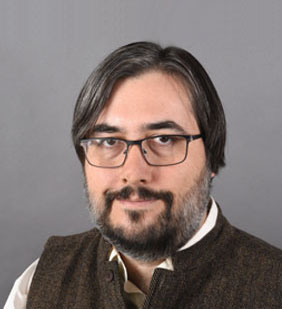
Shaman Hatley
Associate Professor of Asian Studies & Religious Studies
617.287.6138
Biography
Shaman Hatley is a Sanskritist and historian of Indian religions specializing in yoga and Hindu tantric traditions. Before joining UMass Boston in 2015 he taught at Concordia University, Montréal, after completing his Ph.D. at the University of Pennsylvania. He holds a joint appointment in the Asian Studies Department and the Classics and Religious Studies Department.
Area of Expertise
Hinduism, Tantric Śaivism, Hindu goddess traditions (Śāktism), the history of yoga, contemplative studies, Sanskrit religious literature, Bengal studies
Degrees
Ph.D., Religious Studies, the University of Pennsylvania (2007)
M.A., Asian and Middle Eastern Studies, the University of Pennsylvania (2001)
B.A., Liberal Arts, Goddard College (1998)
Professional Publications & Contributions
Recent publications (select):
- Śaivism and the Tantric Traditions: Essays in Honour of Alexis G. J. S. Sanderson, edited by Dominic Goodall, Shaman Hatley, Harunaga Isaacson, & Srilata Raman. Gonda Indological Studies, no. 22. Leiden: Brill, 2020. 598 pp. https://doi.org/10.1163/9789004432802
- The Brahmayāmalatantra or Picumata, Volume I: Chapters 1–2, 39–40, & 83. Revelation, Ritual, and Material Culture in an Early Śaiva Tantra. Collection Indologie, no. 133 (Early Tantra Series, no. 5). Pondicherry: Institut Français d’Indologie/École française d’Extrême-Orient/Universität Hamburg, 2018.
- “The Seven Mothers (Sapta Mātaraḥ): Origin Tales from Two Early-Medieval Purāṇas.” In A Garland of Forgotten Goddesses: Hindu Tales of the Divine Feminine from India and Beyond, edited by Michael Slouber. Berkeley: Unversity of California Press, 2021.
- “Sisters and Consorts, Adepts and Goddesses: Representations of Women in the Brahmayāmala.” In Tantric Communities: Sacred Secrets and Public Rituals, edited by Nina Mirnig, Marion Rastelli, and Vincent Eltschinger, pp. 47–80. Austrian Academy of Sciences Press, 2019.
Recent grants:
- National Endowment for the Humanities (NEH), Scholarly Editions and Translations. Project title: “The Wish-Fulfilling Gem of Yoga: A Critical Edition and Translation of Śivānandasarasvatī’s Yogacintāmaṇi.” Director/PI: Shaman Hatley. Co-directors: Jason Birch and James Mallinson. June 2022–May 2025.
Additional Information
Dr. Hatley's teaching interests include comparative religion, the history, practices and intellectual traditions of Hinduism, South Asian religions and cultural history, and India’s contemplative traditions. Areas of specialization include the history of yoga, the literature, history, and practices of Tantric Śaivism, religion in India’s early-medieval period (circa 500–1200 c.e.), Hindu goddess cults, and Sanskrit religious literature.
One of Hatley’s ongoing subjects of research is the Brahmayāmala (650–750 c.e.), the earliest surviving large-scale tantra (scripture) devoted to goddess worship. He published one volume of studies, critical editions, and translations in 2018 (The Brahmayāmalatantra or Picumata, Volume I: Chapters 1–2, 39–40, & 83. Revelation, Ritual, and Material Culture in an Early Śaiva Tantra) and is preparing another, as well as a companion monograph on tantric yoginī cults in early-medieval India.
Since 2010, Hatley has been contributing to the Tāntrikābhidhānakośa. Dictionnaire des terms techniques de la littérature hindoue tantrique (“A Dictionary of Technical Terms from Hindu Tantric Literature”), published by the Austrian Academy of Sciences.
One current project, funded by the National Endowment for the Humanities, is a critical edition, translation and study of The Wish-fulfilling Gem of Yoga (Yogacintāmaṇi) of Śivānanda Sarasvatī (fl. circa 1600), in collaboration with James Mallinson (Oxford) and Jason Birch (SOAS University of London). Śivānanda’s compendium (nibandha) represents an early and influential endeavor to integrate Patañjali’s ‘classical’ yoga and its rich commentarial tradition with the corpus of second-millennium texts teaching the body-centered practice of Haṭha Yoga. As such, the text offers a unique window into the philosophy and practice of yoga in the early modern era, at the height of the Mughal empire and on the eve of colonialism.
Hatley’s most recent work concerns the history of the ‘tantric body’: its sources, key principles, and historical transformations. At the heart of the project is a genealogy of the tantric cakras (wheels) and kuṇḍalinī (the serpentine vital force believed to ascend through the body in yoga).
